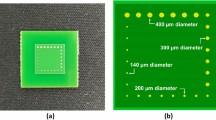Abstract
When lead-free solder alloys mix with lead-free component and board metallizations during reflow soldering, the solder interconnections become multicomponent alloy systems whose microstructures cannot be predicted on the basis of the SnPb metallurgy. To better understand the influences of these microstructures on the reliability of lead-free electronics assemblies, SnAgCu-bumped components were reflow-soldered with near-eutectic SnAgCu solder pastes on Ni(P)|Au- and organic solderability preservative (OSP)-coated printed wiring boards and tested under cyclic thermal shock loading conditions. The reliability performance under thermomechanical loading was found to be controlled by the kinetics of recrystallization. Because ductile fracturing of the as-soldered tin-rich colonies would require a great amount of plastic work, the formation of continuous network of grain boundaries by recrystallization is needed for cracks to nucleate and propagate intergranularly through the solder interconnections. Detailed microstructural observations revealed that cracks nucleate and grow along the grain boundaries especially between the recrystallized part and the non-recrystallized part of the interconnections. The thermal cycling test data were analyzed statistically by combining the Weibull statistics and the analysis of variance. The interconnections on Ni(P)|Au were found out to be more reliable than those on Cu|OSP. This is due to the extensive dissolution of Cu conductor, in the case of the Cu|OSP assemblies, into molten solder that makes the microstructure to differ noticeably from that of the Ni(P)|Au interconnections. Because of large primary Cu6Sn5 particles, the Cu-enriched interconnections enhance the onset of recrystallization, and cracking of the interconnections is therefore faster. The solder paste composition had no statistically significant effect on the reliability performance.
Similar content being viewed by others
References
J.K. Kivilahti and K. Kulojärvi: In Design and Reliability of Solders and Solder Interconnections, edited by R.K. Mahidhara (TMS, Warrendale, PA, 1997), pp. 377–384.
V. Puligandla, S. Dunford, and J.K. Kivilahti: In Handbook of Lead(Pb)-Free Technology for Microelectronics Assemblies, edited by K. Puttliz and K. Stalter (Marcel Dekker Inc., New York, 2004), p. 1026
J.E. Sohn: Are lead-free solder joints reliable? Circuits Assembly June, 32 (2002).
A. Syed: Reliability and Au Embrittlement of Lead Free Solders for BGA Applications. 2001 International Symposium on Advanced Packaging Materials, pp. 143–147.
M. Amagai: Characterization of chip scale packaging materials. Microelectronics Reliability 39, 1365 (1999).
Z.P. Wang, Y.M. Tan, and K.M. Chua: Board level reliability assessment of chip scale packages. Microelectronics Reliability 39, 1351 (1999).
S.R. Lee, B.H.W. Lui, Y.H. Kong, B. Baylon, T. Leung, P. Umali, and H. Agtarap: Assessment of board level solder joint reliability for PBGA assemblies with lead-free solder joints. Soldering and Surface Mount 14, 46 (2002).
E. Bradley and K. Banerji: Effect of PCB Finish on the Reliability and Wettability of Ball Grid Array Packages. IEEE Transactions on Components, Packaging and Manufacturing Technology 19, 320 (1996).
T. Hirano, K. Fukuda, K. Ito, T. Kiga, and Y. Taniguchi: Reliability of Lead Free Solder Joint by Using Chip Size Package. Electronics and the Environment. Proceedings of the 2001 IEEE International Symposium, Piscataway, NJ, pp. 285–289.
P.T. Vianco: An overview of surface finishes and their role in printed circuit board solderability and solder joint performance. Soldering and Surface Mount 25, 6 (1998).
K. Kulojärvi and J.K. Kivilahti: Effect of Dissolution and intermetallic formation on the reliability of flip chip joints— comparison between Cu and Ni. Microelectronics International 15, 20 (1998).
S.K. Kang, D.Y. Shih, K. Fogel, P. Lauro, M.J. Yim, G. Advocate, M. Griffin, C. Goldsmith, D.W. Henderson, T. Gosselin, D. King, J. Konrad, A. Sarkhel, and K.J. Puttliz: Interfacial Reactio Studies on Lead (PB)-Free Solder Alloys. Electronic Components and Technology Conference 2001. Institute of Electrical and Electronics Engineers, Piscataway, NJ.
J. Sigelko, S. Choi, K.N. Subramanian, and J.P. Lucas: The effect of small additions of copper on the aging kinetics of the intermetallic layer and intermetallic particles of eutectic tin-silver solder joints. Journal of Electric Materials 29, 1307 (2000).
C.E. Ho, R.Y. Tsai, Y.L. Lin, and C.R. Kao: Effect of Cu concentration on the reactions between Sn-Ag-Cu solders and Ni. Journal of Electronic Materials 31, 584 (2002).
W.G. Bader: Dissolution and Formation on Intermetallics in the Soldering Process. Proceedings of the Conference on Physical Metallurgy and Metal Joining, edited by R. Kossowsky and M.F. Glicksman (TMS/AIME, Warrendale, PA, 1980).
W.G. Bader: Dissolution of Au, Ag, Pd, Pt, Cu and Ni in a molten Sn-lead solder. Welding Journal 48, 551 (1969).
S. Chada, R.A. Fournelle, W. Laub, and D. Shangguan: Copper substrate dissolution in eutectic Sn-Ag solder and its effect on microstructure. J. Electron. Mater. 29, 1214 (2000).
“IPMA”—The Thermodynamic Databank for Interconnection and Packaging Materials. Helsinki University of Technology, Helsinki (2001).
P. O’Connor: Practical Reliability Engineering, 3rd ed. (John Wiley & Sons Ltd., West Sussex, 1991) p. 431.
K. Zeng, V. Vuorinen, and J.K. Kivilahti: Intermetallic Reactions between Lead-free SnAgCu Solder and Ni(P)/Au Finish on PWB. Proceedings of the 51st Electronic Components and Technology Conference, edited by John Lau. (Institute of Electrical and Electronics Engineers, Piscataway, NJ, 2001) pp. 693–698.
P. Oberndorff: Ph.D. Thesis. Eindhoven University of Technology, The Netherlands (2001).
W. Peng, K. Zeng, and J.K. Kivilahti: Potential Pb-free Solder Systems. Report Series TKK-EVT-1. (Helsinki Univeristy of Technology, Helsinki, 2000).
W.C. Leslie, T.J. Michalak, and F.W. Aul: In Iron and Its Dilute Solid Solutions, edited by C.W. Spencer and F.E. Werner (Interscience Puhlishers, New York, 1963).
R.W. Cahn: Physical Metallurgy (NH Physics, Amsterdam, 1965).
J. Koivisto: M.S. Thesis. Helsinki University of Technology (2004).
Author information
Authors and Affiliations
Rights and permissions
About this article
Cite this article
Mattila, T.T., Vuorinen, V. & Kivilahti, J.K. Impact of printed wiring board coatings on the reliability of lead-free chip-scale package interconnections. Journal of Materials Research 19, 3214–3223 (2004). https://doi.org/10.1557/JMR.2004.0436
Received:
Accepted:
Published:
Issue Date:
DOI: https://doi.org/10.1557/JMR.2004.0436




